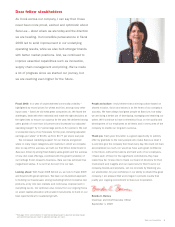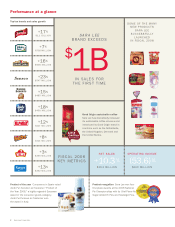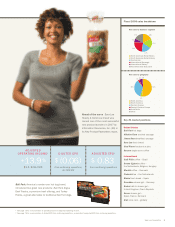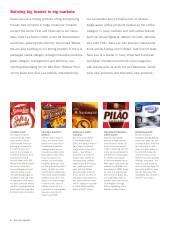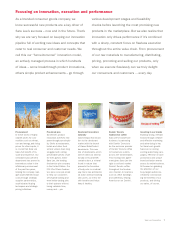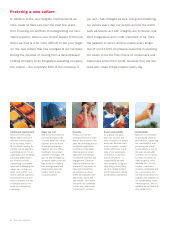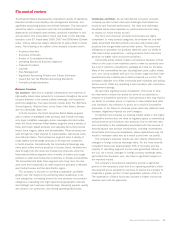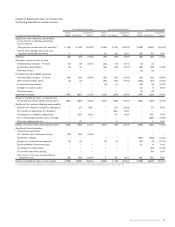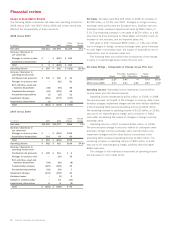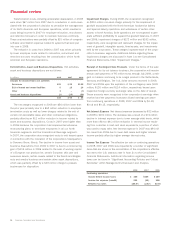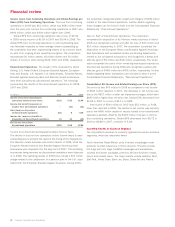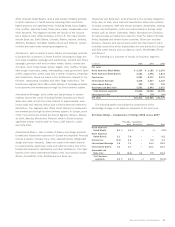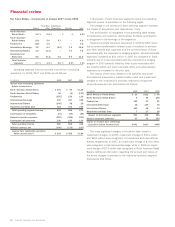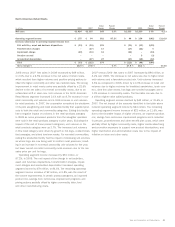Sara Lee 2008 Annual Report Download - page 13
Download and view the complete annual report
Please find page 13 of the 2008 Sara Lee annual report below. You can navigate through the pages in the report by either clicking on the pages listed below, or by using the keyword search tool below to find specific information within the annual report.Sara Lee Corporation and Subsidiaries 11
This Financial Review discusses the corporation’s results of operations,
financial condition and liquidity, risk management activities, and
significant accounting policies and critical estimates. This discussion
should be read in conjunction with the Consolidated Financial
Statements and related notes thereto contained elsewhere in this
annual report. The corporation’s fiscal year ends on the Saturday
closest to June 30. Fiscal years 2008, 2007 and 2006 were 52-week
years. Unless otherwise stated, references to years relate to fiscal
years. The following is an outline of the analysis included herein:
•Business Overview
•Summary of Results
•Review of Consolidated Results
•Operating Results by Business Segment
•Financial Condition
•Liquidity
•Risk Management
•Significant Accounting Policies and Critical Estimates
•Issued But Not Yet Effective Accounting Standards
•Forward-Looking Information
Business Overview
Our Business Sara Lee is a global manufacturer and marketer of
high-quality, brand name products for consumers throughout the world
focused primarily in the meats, bakery, beverage, and household
products categories. Our major brands include
Ambi Pur, Ball Park,
Douwe Egberts, Hillshire Farm, Jimmy Dean, Kiwi, Sanex, Senseo
and our namesake,
Sara Lee.
In North America, the North American Retail Meats segment
sells a variety of packaged meat products that include hot dogs,
corn dogs, breakfast sausages, dinner sausages and deli meats,
while the North American Retail Bakery segment sells a variety of
fresh and frozen baked products and specialty items that include
bread, buns, bagels, cakes and cheesecakes. These products are
sold through the retail channel to supermarkets, warehouse clubs
and national chains. The Foodservice segment sells a variety of
meat, bakery and beverage products to foodservice customers
in North America. Internationally, the International Beverage seg-
ment sells coffee and tea products in Europe, Brazil, Australia and
Asia through both the retail and foodservice channels, while the
International Bakery segment sells a variety of bakery and dough
products to retail and foodservice customers in Europe and Australia.
The Household and Body Care segment sells body care, air care,
shoe care and insecticides to retail customers primarily in Western
and Central Europe and the Asia Pacific region.
The company is focused on building sustainable, profitable
growth over the long term by achieving share leadership in its
core categories; innovating around its core products and product
categories; expanding into high opportunity geographic markets
and strategic joint ventures/partnerships; delivering superior quality
and value to our customers; and driving operating efficiencies.
Challenges and Risks As an international consumer products
company, we face certain risks and challenges that impact our
business and financial performance. The risks and challenges
described below have impacted our performance and are likely
to impact our future results as well.
The food and consumer products businesses are highly
competitive. In many product categories, we compete not only with
widely advertised branded products, but also with private label
products that are generally sold at lower prices. The consumers’
willingness to purchase our products depends upon our ability to
offer brand value propositions – selling products that consumers
perceive as higher value at economical prices.
Commodity prices directly impact our business because of their
effect on the cost of raw materials used to make our products and
the cost of inputs to manufacture, package and ship our products.
Many of the commodities we use, including beef, pork, coffee, wheat,
corn, corn syrup, soybean and corn oils, butter, sugar and fuel, have
experienced price volatility due to factors beyond our control. The
company’s objective is to offset commodity price increases with pricing
actions and to offset any operating costs increases with continuous
improvement savings.
We also face significant price competition. From time to time,
we may need to reduce the prices for some of our products to
respond to competitive pressures. Such pressures also may restrict
our ability to increase prices in response to raw material and other
cost increases. Any reduction in prices as a result of competitive
pressures, or our failure to increase prices when raw material costs
increase, negatively impacts our profit margins.
To maintain and increase our existing market share in this highly
competitive environment, we need to regularly spend on advertising
and promotions and introduce new products. Due to inherent risks
and uncertainty in the marketplace associated with the success of
advertising and new product introductions, including uncertainties
about trade and consumer acceptance, these expenditures may not
result in increased sales and as a result could lower our profits.
The company’s business results are also heavily influenced by
changes in foreign currency exchange rates. For the most recently
completed fiscal year, approximately 50% of net sales and the
majority of operating segment income were generated outside of
the U.S. As a result, changes in foreign currency exchange rates,
particularly the European euro, can have a significant impact on
the reported results.
The company’s international operations provide a significant
portion of the company’s cash flow from operating activities, which
has required and is expected to continue to require the company to
repatriate a greater portion of cash generated outside of the U.S.
The repatriation of these funds has resulted in higher income tax
expense and cash tax payments.
Financial review


